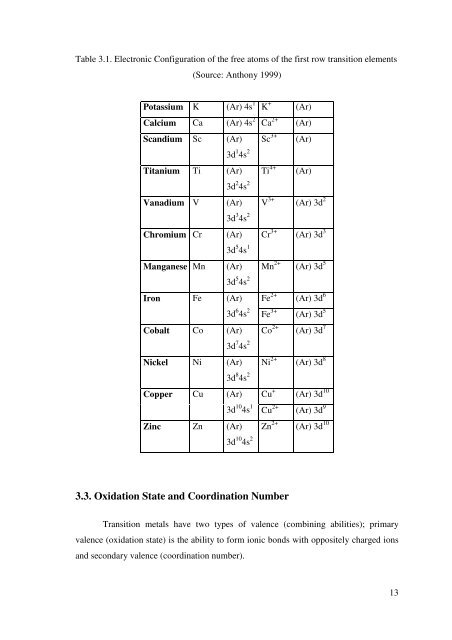the production of thymoquinone from thymol and carvacrol
the production of thymoquinone from thymol and carvacrol
the production of thymoquinone from thymol and carvacrol
Create successful ePaper yourself
Turn your PDF publications into a flip-book with our unique Google optimized e-Paper software.
Table 3.1. Electronic Configuration <strong>of</strong> <strong>the</strong> free atoms <strong>of</strong> <strong>the</strong> first row transition elements<br />
(Source: Anthony 1999)<br />
Potassium K (Ar) 4s 1 K + (Ar)<br />
Calcium Ca (Ar) 4s 2 Ca 2+ (Ar)<br />
Sc<strong>and</strong>ium Sc (Ar)<br />
3d 1 4s 2<br />
Titanium Ti (Ar)<br />
3d 2 4s 2<br />
Vanadium V (Ar)<br />
3d 3 4s 2<br />
Chromium Cr (Ar)<br />
3d 5 4s 1<br />
Manganese Mn (Ar)<br />
3d 5 4s 2<br />
Iron Fe (Ar)<br />
Cobalt Co (Ar)<br />
Sc 3+ (Ar)<br />
Ti 4+ (Ar)<br />
V 3+ (Ar) 3d 2<br />
Cr 3+ (Ar) 3d 3<br />
Mn 2+ (Ar) 3d 5<br />
Fe 2+ (Ar) 3d 6<br />
3d 6 4s 2 Fe 3+ (Ar) 3d 5<br />
3d 7 4s 2<br />
Nickel Ni (Ar)<br />
3d 8 4s 2<br />
Copper Cu (Ar)<br />
Zinc Zn (Ar)<br />
Co 2+ (Ar) 3d 7<br />
Ni 2+ (Ar) 3d 8<br />
Cu + (Ar) 3d 10<br />
3d 10 4s 1 Cu 2+ (Ar) 3d 9<br />
3d 10 4s 2<br />
3.3. Oxidation State <strong>and</strong> Coordination Number<br />
Zn 2+ (Ar) 3d 10<br />
Transition metals have two types <strong>of</strong> valence (combining abilities); primary<br />
valence (oxidation state) is <strong>the</strong> ability to form ionic bonds with oppositely charged ions<br />
<strong>and</strong> secondary valence (coordination number).<br />
13
















